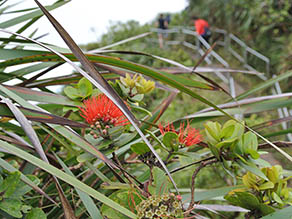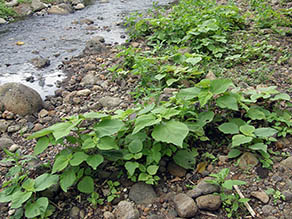 |
 |
 |
 |
||||||
|
|
|
|
|
|
|
|
|
|
|
| Areas | Seasons | Forest | Ocean | Sky | Language | Sources & Links | |||||||||
 |
|
 |
|||||||
 |

“On the top ridge, some of the trees that are still up there used to be the most dominant tree in the lowlands,” Rick says, beginning our walk-through of vegetation in the ahupua‘a. “I’m speaking specifically of the loulu palm, which is the fan palm. On O‘ahu, there were multiple pollen core samples that were taken in various places, and all of those pollen core samples revealed that the pollen of loulu was one of the most dominant trees in the lowlands. And then the ‘ōhi‘a lehua was a dominant tree. And there’s a few lama trees, there’s some halapepe trees. There’s actually olonā up there. 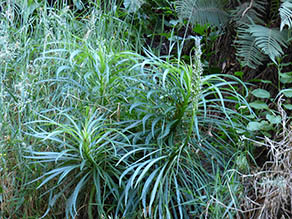
“Up top, there’s a few native lobelia still. There’s a few different species of lobelias. There’s cyaneas up on the top. There’s lobelia, the genus lobelia. There was a Lobelia hypoleuca coming out of the stairs on the Stairway to Heaven. “Then because of the drastic change in elevation, it goes from a wet forest pretty much almost immediately into a mesic forest. And a mesic forest is that intermediate area between wet and dry. “Within the ahupua‘a of He‘eia, you have Ha‘ikū Valley, and then right next door you have ‘Ioleka‘a. So both of those valleys are within the ahupua‘a of He‘eia. And the ridge that’s separating them is pretty dry, but they’re still good pockets of pala‘ā fern. That’s where you see some of the dry forest plants that would’ve been further down here. “This entire valley. probably until the foot of these cliffs on other side, would have been in that mesic zone, except for the drier ridges, these lower ridges. ‘Ōhi‘a and loulu, I would say, would have been the dominant species. There’s a few koa trees still, but very little. I did see some Reynolsia, which is ‘ohe makai. And lama. “In the back of the valley, there’s some really interesting diversity. There’s a Hesperomannia, which is an extremely rare tree in the sunflower family. It’s easily in the top five rarest trees on O‘ahu. “So mamaki, ‘ōhi‘a, probably a bunch of native lobelias, cyaneas within that mesic zone; lamas, that also would come down into the dry forest area; alahe‘e, that comes down into the dry forest area. Further back there is native hibiscus. I know right on the other side of the valley in Hālawa Valley, there was a red hibiscus and there’s also a bunch of native white hibiscus. “There’s a naupaka kuahiwi, which is the mountain naupaka, on these ridges on this side and on that side. Probably a couple of different species of ‘akia kuahiwi, Wikstroemia is the genus. And then when you come down lower into these areas, so the wetland species. Even within the wetlands, in addition to the neke fern and the ‘uki grass, there was guarantee—because I’ve seen it pop up before—kaluha. There’s a bunch of different native plants called kaluha, but specifically the Bolboschoenus maritimus. 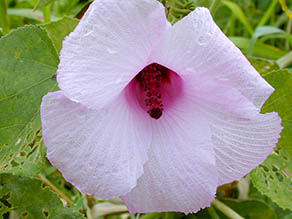
‘Ae‘ae, the Bacopa monnieri. And then I know in Kailua, there’s ‘akiohala which is a....they call it the wetland hibiscus. It’s got a nice, big purple flower. And in Waihe‘e, we found some. Probably some over here too, probably a whole bunch where Kako‘o is. It’s just that you don’t always see it. “On the valley floor, you would get a lot of that same mixture. But then once Hawaiians came in, then that altered the landscape to make it more agricultural-based. That’s when you’re looking at the kalo, and the ‘uala, and the ‘ulu; all of them do really well over here. The water is great. There’s a lot of water in this valley.” Read about the relationship between the forest and the kūahu hula altar “All of Kako‘o ‘Ōiwi was a wetland, 400 acres of wetland. Even up to over here, I think following this ridgeline down that separates ‘Ioleka‘a and Ha‘ikū Valley, right around the base of that bridge I believe was all wetlands. Because even over here where our terraces are, there’s areas that seem very wetland, which is kind of probably the reason why Hawaiians turned them into agricultural terraces. “I’m basing that just off of some of the native plants that you can still find up there today, which leads me to say that there’s neke ferns. Neke ferns I usually associate it with wetland areas, whether it be way up in the mountains or down in lower elevations, you’ll find neke fern. There’s still a bunch of neke fern; when we were clearing and restoring our lo‘is, neke fern naturally popped up. That was actually a great sign. 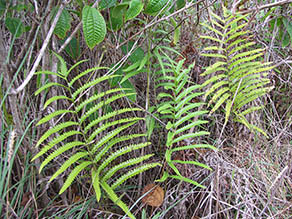
“Culturally, if you have neke fern growing in your lo‘i, then it was supposed to be a bountiful lo‘i. So wherever a neke could grow, that was also a great place to grow kalo. That’s what Hawaiians believe. “We found a big patch of Cladium jamaisence, which is saw grass, like in the Everglades—all the saw grasses that they ride the fan boats through? That’s actually native to Hawai‘i too. In Hawai‘i it would be called ‘uki, and we found that, but those are literally wetland plants. Not the ‘uki‘uki. There’s actually a lot of native plants called either ‘uki or ‘uki‘uki. ‘Uki‘uki is Dianella but then there’s a whole other list of plants called ‘uki. So that leads me to believe that this whole area down here at the foot of these ridges were wetlands. Rick talks about the issues of scientific naming “With the alteration of the native vegetation when Polynesians came in and turned everything into agriculture, today in these lower valleys, you’ll find mountain apples, you’ll find shampoo ginger, ‘ ulu, Hawaiian bamboo. Sugar cane, we didn’t find any. We found ‘awa. We found some natural ‘awa. And then along the riparian sections and the more wetter sections of the valley, we found māmaki naturally growing. “And then as you move your way out from the valley areas and now it’s just flatland going out, dry forest and coastal. But even still, in the loosely sense, dry forest because we’re on the Windward side, we tend to have a little bit more rain. And this whole area in the lower reaches going up towards the valley walls, another dominant tree would have been hala. Hala and coconuts. "Coconuts [niu] are classified as indigenous. For the longest time, it was believed to have been just Polynesian-introduced. They’re indigenous now, because in Hawai‘i, we have niu hiwa, and then we have regular niu. And niu hiwa to my personal belief is not only an indigenous type of coconut, but I think it is endemic. It’s hard to get a cultivar as unique as niu hiwa within the time that Hawaiians settled in Hawai‘i. And so, to my personal belief, I would classify niu hiwa as an endemic variety of coconut. And we find those trees all in here. “Even with the agricultural change of plants, with the taro and the ‘ulu, we can still see some areas, the native hala and kou trees. There’s kamani trees still over here. That’s Polynesian-introduced. A lot of the Polynesian-introduced trees are starting to become the more dominant canopy trees and taking over the hala and the ‘ōhi‘a, and probably wiliwili, or something on the drier ridges, the more exposed ridges. Rick explains about Hawaiian mintless mint “There’s no documentation of āulu on this side, but I think that tree was a lot more widespread than it currently is located. It’s Sapindus oahuensis. It’s a native soapberry that’s only found on Kaua‘i and O‘ahu specifically. There’s another soapberry called Sapindus saponaria, which is, unlike the Sapindus oahuensis which is endemic, the saponaria is indigenous because it’s only found on the Big Island, but it’s also found on other parts of the Pacific, or I think like Southeast Asia or something, I don’t know. 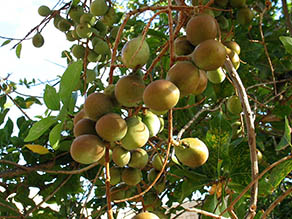
“And the same thing with milo. Milo is an introduced tree. That’s another tree that would’ve been a dominant one in this area once Polynesians settled. We see a lot of milo. Even down at the fish pond, there’s still tons of milo.” “The coastline is actually hard to tell because there’s so much freshwater influx over here, all the estuaries that envelop this coastline, and so much of the coastline was dedicated to fishponds. I think the coastline here as opposed to other parts that have more wind. Because we’re protected from the bay, there’s not a lot of surf. So there’s not a lot of churning of the sand or creation of sand. "There are areas over here where the vegetation is a lot different than a stone’s throw away on the Marine base. Or right around the corner at Kualoa. The coastal strand vegetation is totally different, and you get a lot of estuary-type plants, which is why once mangroves got introduced into Hawai‘i, it just took off like wildfire over here because of how calm the water is, the interaction of freshwater-saltwater, and basically all of the fishponds just created beautiful harbors to have this plant just take over.”
|
 |
|
 |
The plants of the forest, in Hawaiian culture, are directly linked to the living beings of the Ocean.
|
 |
||
 |
|
 |
||

|
 |
||||
|
||||
Copyright 2019 Pacific Worlds & Associates • Usage Policy • Webmaster |
||||
